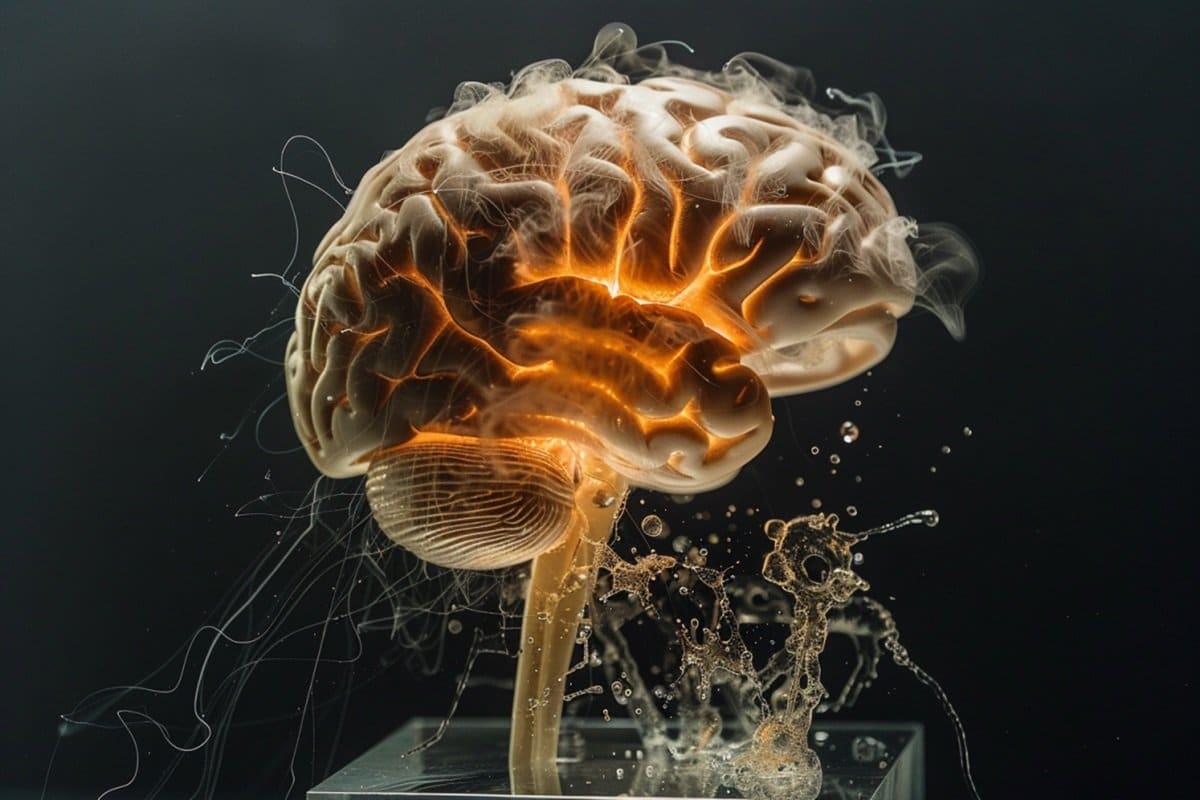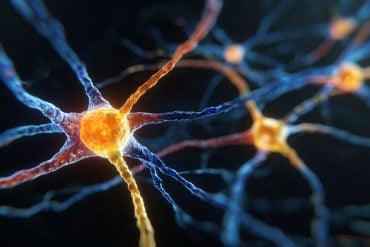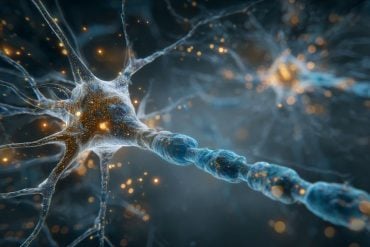Summary: Researchers have discovered that neuropeptides, not neurotransmitters, are the primary messengers in the brain’s fear circuit. This finding could lead to better painkillers and treatments for fear-related conditions.
Using innovative tools, scientists observed neuropeptide release during fear responses in live mice. The study highlights the potential of targeting multiple neuropeptides for more effective therapies.
Key Facts:
- Neuropeptides are the primary messengers in the brain’s fear circuit.
- New tools allow real-time observation of neuropeptide release in live mice.
- Targeting multiple neuropeptides could improve treatments for PTSD and pain.
Source: Salk Institute
In the split second as you accidentally touch the hot handle of a cast iron skillet, pain and a sense of danger rush in. Sensory signals travel from the pain receptors in your finger, up through your spinal cord, and into your brainstem. Once there, a special group of neurons relays those pain signals to a higher brain area called the amygdala, where they trigger your emotional fear response and help you remember to avoid hot skillets in the future.
This process of translating pain into a threat memory occurs so quickly that scientists thought it must be mediated by fast-acting molecules called neurotransmitters. But when Salk researchers investigated the role of larger, slower-acting molecules called neuropeptides, they discovered these were the primary messengers in this fear circuit.

Neuropeptides are known to play an important role in brain communication, but the details have been unclear because scientists didn’t have the proper tools to study them in behaving animals.
To determine the role of neuropeptides in this circuit, the Salk team created two new tools that finally allow scientists to observe and manipulate neuropeptide release in the brains of live mice.
The new study, published in Cell on July 22, 2024, revealed that the danger circuit relies on neuropeptides, not neurotransmitters, as its primary messengers, and more than one neuropeptide is involved in the process.
Their findings could lead to the development of more effective painkillers or new treatments for fear-related conditions like anxiety and PTSD (post-traumatic stress disorder).
“There is so much we have left to uncover about neuropeptides, but thankfully at Salk, we have the legacy of Nobel Prize winner Roger Guillemin’s work to highlight their importance and encourage our discovery,” says senior author Sung Han, associate professor and Pioneer Fund Development Chair at Salk.
“To do this, we created two genetically encoded tools for monitoring and silencing neuropeptide release from nerve endings. We believe these new tools will significantly advance the field of neuropeptide research, and our discovery of their role in fear processing is really just the beginning.”
To process and react to things in our environment, information must travel throughout our body and brain. These signals are sent and received by neurons, which form organized circuits that guide information where it needs to go. Neurons communicate with each other by sending and receiving molecules like neurotransmitters and neuropeptides.
Neuropeptides are generally accepted as neuromodulators that help and modulate the action of main neurotransmitters. However, early pioneers like Roger Guillemin proposed that neuropeptides can act as main transmitters themselves.
This concept has not been rigorously tested due to the lack of tools for visualizing and manipulating their release in behaving animals. The Salk team set out to explore neuropeptides with the goal of developing new tools to better understand their role in brain circuits.
To specifically target neuropeptides, Han’s team took advantage of one of their unique characteristics—while neurotransmitters are packaged in small spheres called synaptic vesicles, neuropeptides are packaged in large dense core vesicles. By engineering biochemical tools to target these large vesicles, they created neuropeptide sensor and silencer tools.
The sensor tags large dense core vesicles with proteins that glow when they are released from the nerve ending, allowing the researchers to watch neuropeptide release in live time. The silencer specifically degrades neuropeptides within large dense core vesicles, revealing what happens in the brain when neuropeptides are absent.
“We have created a novel way to trace neuropeptide travel and function in the brains of living animals,” says Dong-Il Kim, first author of the study and postdoctoral researcher in Han’s lab.
“These tools will help further our understanding of the brain’s neuropeptide circuits and enable neuroscientists to explore questions that were previously difficult to address.”
Using their newly developed neuropeptide sensor and silencer, together with existing sensor and silencer tools for glutamate (the brain’s most abundant neurotransmitter), the researchers looked at how neuropeptides and glutamate behaved in live mice as they experienced a mild stimulus—just enough to stimulate the fear circuit.
They found that neuropeptides, but not glutamate, were released during the stimulus. What’s more, silencing neuropeptide release reduced fear behaviors in the mice, but silencing glutamate had no effect.
To Han’s surprise and delight, this brainstem fear circuit relied on neuropeptides as its primary messenger molecules rather than glutamate. Furthermore, their findings support their ongoing investigation into PACAP—a neuropeptide that modulates panic disorder.
“These new tools and discoveries are an important step toward better neurological drug development,” says Han. “We found that multiple neuropeptides are packaged together in a single vesicle and released all at once by a painful stimulus to function in this fear circuit, which made us think, ‘This might be why some drugs that target only one neuropeptide are failing in clinical trials.’
“With this new information, we can provide insights to develop new drugs that target multiple neuropeptide receptors at once, which may serve as better painkillers or help treat fear-related disorders like PTSD.”
Equipped with their new neuropeptide toolbox, the team will soon begin to explore other brain circuits and processes. Future insights into neuropeptide signaling in other areas of the brain, as well as the newfound understanding that targeting multiple neuropeptides at once is necessary, should inspire the development of more effective drugs to treat diverse neurological disorders.
Other authors include Seahyung Park, Mao Ye, Sukjae Kang, Jinho Jhang, Joan Vaughan, and Alan Saghatelian of Salk; Sekun Park, Jane Chen, Avery Hunker, Larry Zweifel, and Richard Palmiter of University of Washington; and Kathleen Caron of University of North Carolina at Chapel Hill.
Funding: The work was supported by the National Institutes of Health (NIMH 5R01MH116203, NINDS 1RF1NS128680) and a Salk Institute Innovation Grant.
About this fear and neuroscience research news
Author: Salk Comm
Source: Salk Institute
Contact: Salk Comm – Salk Institute
Image: The image is credited to Neuroscience News
Original Research: Closed access.
“Presynaptic sensor and silencer of peptidergic transmission reveal neuropeptides as primary transmitters in pontine fear circuit” by Sung Han et al. Cell
Abstract
Presynaptic sensor and silencer of peptidergic transmission reveal neuropeptides as primary transmitters in pontine fear circuit
Highlights
- CybSEP2 is a genetically encoded LDCV sensor for presynaptic neuropeptide release
- NEPLDCV is a genetically encoded silencer for peptidergic transmission
- Neuropeptides, not glutamate, are primary transmitters in the CGRPPBel→CeA US circuit
- Multiple neuropeptides, not CGRP alone, are required for CGRPPBel→CeA pain transmission
Summary
Neurons produce and release neuropeptides to communicate with one another. Despite their importance in brain function, circuit-based mechanisms of peptidergic transmission are poorly understood, primarily due to the lack of tools for monitoring and manipulating neuropeptide release in vivo.
Here, we report the development of two genetically encoded tools for investigating peptidergic transmission in behaving mice: a genetically encoded large dense core vesicle (LDCV) sensor that detects presynaptic neuropeptide release and a genetically encoded silencer that specifically degrades neuropeptides inside LDCVs.
Using these tools, we show that neuropeptides, not glutamate, encode the unconditioned stimulus in the parabrachial-to-amygdalar threat pathway during Pavlovian threat learning.
We also show that neuropeptides play important roles in encoding positive valence and suppressing conditioned threat response in the amygdala-to-parabrachial endogenous opioidergic circuit.
These results show that our sensor and silencer for presynaptic peptidergic transmission are reliable tools to investigate neuropeptidergic systems in awake, behaving animals.






